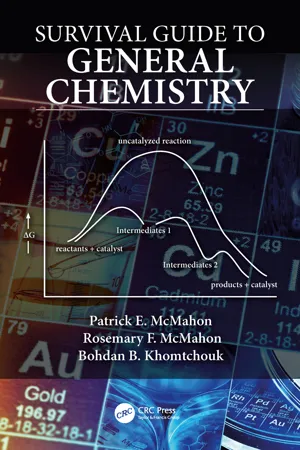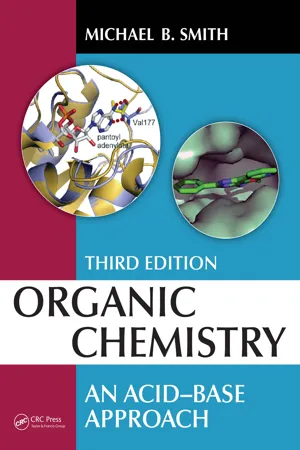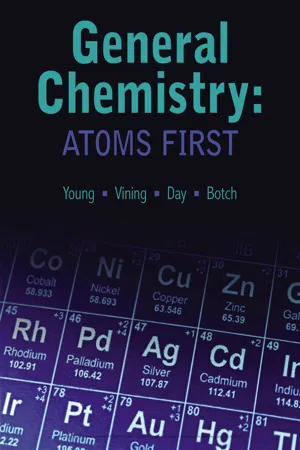Chemistry
Bond Enthalpy
Bond enthalpy is the energy required to break a chemical bond. It is a measure of the strength of a bond and is typically expressed in kilojoules per mole (kJ/mol). When a bond is broken, energy is absorbed, and when a bond is formed, energy is released. Bond enthalpy values are useful for predicting the energy changes in chemical reactions.
Written by Perlego with AI-assistance
Related key terms
1 of 5
8 Key excerpts on "Bond Enthalpy"
- eBook - PDF
Foundations of Chemistry
An Introductory Course for Science Students
- Philippa B. Cranwell, Elizabeth M. Page(Authors)
- 2021(Publication Date)
- Wiley(Publisher)
The bond energy refers to the energy required to break one mole of bonds of the specified type in a molecule in the gaseous state. For a Cl ─ Cl bond, it is defined as: Cl 2 g 2Cl g E Cl ─ Cl = + 242 kJ mol − 1 When a new bond is formed, the amount of energy released is the same as the energy required to break the bond. This is a consequence of the first law of ther-modynamics. The enthalpy change for the formation of a molecule of chlorine from two chlorine atoms is represented by: 2Cl g Cl 2 g E Cl ─ Cl = − 242 kJ mol − 1 The magnitude of the enthalpy change is the same, but the sign is opposite, as bond formation is exothermic. The values quoted are mean bond energies . This is because the strength of any bond depends upon the chemical environment around that bond. For exam-ple, the O ─ H bond energy in the water molecule, H 2 O, will be slightly different to the value for the O ─ H bond in ethanol, C 2 H 5 OH, and different again from the value in hydrogen peroxide, H 2 O 2 . The mean bond energy is obtained by taking the average of bond energies from a number of the same types of bond in different molecules or chemical environments. Water Ethanol Hydro g en peroxide H O H C O C H H H O O H H H H H Table 6.1 gives some typical values for mean bond dissociation energies. It can be seen from the table that the values for bond energies vary quite a lot depending upon the nature of the bond. For bonds between atoms of the same element, the mean bond energy increases with bond order. It takes more energy to break a double bond than a single bond and more energy again to break a triple bond. This can be seen for the bond energies for different types of C ─ C bonds, as shown: E C ─ C = 348 kJ mol − 1 E C = C = 612 kJ mol − 1 E C C = 837 kJ mol − 1 The bond order refers to whether the bond is a single, double or tri-ple bond. 6.1 Enthalpy changes 169 - eBook - PDF
- William R. Robinson, Edward J. Neth, Paul Flowers, Klaus Theopold, Richard Langley(Authors)
- 2016(Publication Date)
- Openstax(Publisher)
required to break the bond between the two atoms. It is essential to remember that energy must be added to break chemical bonds (an endothermic process), whereas forming chemical bonds releases energy (an exothermic process). In the case of H 2 , the covalent bond is very strong; a large amount of energy, 436 kJ, must be added to break the bonds in one mole of hydrogen molecules and cause the atoms to separate: H 2 (g) ⟶ 2H(g) bond energy = 436 kJ Conversely, the same amount of energy is released when one mole of H 2 molecules forms from two moles of H atoms: 2H(g) ⟶ H 2 (g) bond energy = −436 kJ Bond Strength: Covalent Bonds Stable molecules exist because covalent bonds hold the atoms together. We measure the strength of a covalent bond by the energy required to break it, that is, the energy necessary to separate the bonded atoms. Separating any pair of bonded atoms requires energy (see Figure 4.4). The stronger a bond, the greater the energy required to break it. The energy required to break a specific covalent bond in one mole of gaseous molecules is called the bond energy or the bond dissociation energy. The bond energy for a diatomic molecule, D X–Y , is defined as the standard enthalpy change for the endothermic reaction: XY(g) ⟶ X(g) + Y(g) D X−Y = ΔH° For example, the bond energy of the pure covalent H–H bond, D H–H , is 436 kJ per mole of H–H bonds broken: H 2 (g) ⟶ 2H(g) D H−H = ΔH° = 436 kJ Molecules with three or more atoms have two or more bonds. The sum of all bond energies in such a molecule is equal to the standard enthalpy change for the endothermic reaction that breaks all the bonds in the molecule. For example, the sum of the four C–H bond energies in CH 4 , 1660 kJ, is equal to the standard enthalpy change of the reaction: The average C–H bond energy, D C–H , is 1660/4 = 415 kJ/mol because there are four moles of C–H bonds broken per mole of the reaction. - eBook - ePub
- Patrick E. McMahon, Rosemary McMahon, Bohdan Khomtchouk(Authors)
- 2019(Publication Date)
- CRC Press(Publisher)
Chapter 19 ), a useful working definition of enthalpy can be applied: change in enthalpy (ΔH) can be thought of as the change in the potential energy (ΔPE) of a chemical process as measured by heat transfer to the surroundings. In a limited sense, the “surroundings” essentially represent the matter that contains the chemical process: the solvent in a solution of reactants, the container holding the reactants, and potentially other factors.Enthalpy, as a measure of potential energy change, has equivalent meaning for signs: (−ΔPE of reaction) equates to (−ΔH of reaction). In this case, the potential energy decreases, and energy is released to the surroundings; the reaction is termed exothermic (“heat out”).(+ΔPE of reaction) equates to (+ΔH of reaction). In this case, the potential energy increases, and energy is required to be added from the surroundings; the reaction is termed endothermic (“heat in”).Stronger bonds equate to lower PE; molecules with stronger total bonds are more stable and are lower in potential energy than molecules with weaker total bonds. The BDE of a bond is always a positive value; it is equal in value but opposite in sign to the bonding potential energy PE Stronger bonds will have higher values for BDE; weaker bonds will have smaller values for BDE.Molecules with:For calculation purposes, measurement of bond energies is usually expressed in terms of the bond dissociation energy, BDE. For calculations, the following equation, applying an enthalpy measurement for potential energy can be used.ΔH (reaction) = [total bond BDE (reactants)] − [total bond BDE (products)]A conventional chemical reaction describes the process of converting a specific set of reactants to a specific set of products. The corresponding balanced equation, read from left-to-right, describes what is termed the forward - eBook - PDF
Chemistry
Structure and Dynamics
- James N. Spencer, George M. Bodner, Lyman H. Rickard(Authors)
- 2011(Publication Date)
- Wiley(Publisher)
All gases have a partial pressures of 1 bar, or 0.9869 atm. (This can be rounded to 1 atm for all but the most exact calculations.) Enthalpy measurements done under the standard-state condition are indicated by adding a superscript ° to the symbol for enthalpy. The standard-state enthalpy of reaction for the combustion of methane at 25°C, for example, would be reported as follows. ¢H° 298 802.4 kJ/mol rxn 7.12 Calculating Enthalpies of Reaction The origin of the change in enthalpy that accompanies a chemical reaction can be seen more clearly by examining the bonds in the products and reactants in the following reaction. We can use Lewis structures to visualize the bonds that have to be broken and the bonds that have to be formed in this reaction. Once again, we can assume a hypothetical two-step process for converting reactants into products. The first step involves breaking all of the bonds in the starting materials to form isolated atoms in the gas phase. Note that a carbon– oxygen triple bond and two hydrogen–oxygen single bonds are broken in this step, which is endothermic because bonds are being broken. The isolated atoms can then recombine to make the bonds necessary to form the products of the reaction. Because this step involves making bonds, it must be exothermic. Experimentally we find that it takes 1076.4 kJ/mol rxn to break the C‚O triple bonds in a mole of CO molecules to form isolated C and O atoms in the gas phase. It takes an additional 926.3 kJ/mol rxn to break the bonds in a mole of C(g) 2 O(g) 2 H(g) CO 2 (g) H 2 (g) C(g) 2 O(g) 2 H(g) CO(g) H 2 O(g) O O P P S S O Q q C C O O O O H H H O H Δ CO(g) + H 2 O(g) ¡ CO 2 (g) + H 2 (g) ➤ CHECKPOINT What does the symbol mean? ¢H° 373 7.13 ENTHALPIES OF ATOM COMBINATION 289 H 2 O molecules to form isolated H and O atoms. Thus the bond-breaking process takes a total of 2002.7 kJ per mole of reaction. - eBook - ePub
Organic Chemistry
An Acid-Base Approach, Third Edition
- Michael B. Smith(Author)
- 2022(Publication Date)
- CRC Press(Publisher)
ionic compound NaI) reacts with chloromethane to give the chloride ion and iodomethane as products. The solvent is the ether THF (tetrahydrofuran, Sections 5.5.2 and 6.7.3), shown under the reaction arrow.It does not participate in the bond-making and bond-breaking process. The iodide ion reacts as a nucleophile with carbon of the C—Cl unit, which is broken. Chloromethane, the starting material , is always drawn on the left side of the equation. A new C—I bond is formed in iodomethane, the product , which is always drawn on the right side of the equation. The bond strength for the C—Cl bond in chloromethane is 84 kcal (351.5 kJ) mol-1 and the bond strength of C—I in iodomethane is 56 kcal (234.3 kJ) mol-1 , as shown in Table 7.1 .1 The change in energy from reactant to product is the difference in the two values of H° or ΔH° (change in energy), and ΔH° is H°(bonds broken) - H°(bonds made) . For the reaction shown, ΔH° is1 Haynes, W.M. CRC Handbook of Chemistry, 94th ed., CRC Press, Inc., Boca Raton, FL, 2013–2014, pp. 9–71 to 9–79.Table 7.1 Selected Bond Dissociation Energy Values for Bonds In Specific MoleculesΔ H =H−bonds brokenHand Δ H =bonds madeH−Cl − CHC − IΔ H = 84 kcal351.5 kJ− 56 kcalmol− 1234.3 kJ= 28 kcalmol− 1117.2mol− 1The free energy (ΔG°) is the important parameter. If the ΔS° is very small and assumed to be zero, it is clear the calculated value of ΔH° is close to the value of ΔG°, measured in kilocalories. The difference is usually only a few calories. The positive sign for ΔG° (from ΔH°) for this substitution reaction means that this is an endothermic reaction (endergonic) - eBook - PDF
- Young, William Vining, Roberta Day, Beatrice Botch(Authors)
- 2017(Publication Date)
- Cengage Learning EMEA(Publisher)
Copyright 2018 Cengage Learning. All Rights Reserved. May not be copied, scanned, or duplicated, in whole or in part. WCN 02-300 Unit 10 Thermochemistry 305 ● Enthalpy is an extensive variable; it is dependent on the amount of substance present (10.4b). ● Bond energy values can be used to calculate the enthalpy change for gas-phase reactions (10.4c). ● Calorimetry is used to determine enthalpy of reaction values (10.4d). ● Constant-pressure (coffee-cup) calorimetry experiments measure enthalpy change for a reaction (10.4d). ● Constant-volume (bomb) calorimetry experiments measure a change in internal energy (10.4e). 10.5 Hess’s Law ● Enthalpy is a state function (10.5a). ● Hess’s Law states that if a reaction can be carried out in a series of steps, the overall enthalpy change for the reaction is the sum of the enthalpy changes for the series of steps (10.5a). 10.6 Standard Heats of Reaction ● Standard enthalpy change is measured under standard conditions, where substances are in their most stable form at bar and a given temperature, and all solutions have a concentration of mol/L (10.6a). ● Standard heat of formation is the enthalpy change for the formation of one mole of a substance from its constituent elements, all in their standard states (10.6a). ● The standard enthalpy of a reaction can be calculated using standard heats of reaction for the reactants and products (10.6b). Key Equations KE 5 ½ mv 2 (10.1) D E system 5 q 1 w (10.2) D E universe 5 0 (10.3) H 5 E 1 PV (10.4) c , specific heat capacity (J > g # °C) 5 q , heat energy absorbed (J) m , mass (g) 3 D T , change in temperature (°C) (10.5) D H ° 5 g (energies of bonds broken) 2 g (energies of bonds formed) (10.6) D H ° rxn 5 g D H f °(products) 2 g D H f °(reactants) (10.7) Copyright 2018 Cengage Learning. All Rights Reserved. May not be copied, scanned, or duplicated, in whole or in part. WCN 02-300 - eBook - PDF
Inorganic Chemistry
An Industrial and Environmental Perspective
- Thomas W. Swaddle(Author)
- 1997(Publication Date)
- Academic Press(Publisher)
Unfortunately, there is sometimes confusion over what exactly we mean by bond energy. We could define a mean bond energy E as the contribu- tion of an A--B pair to the total energy of the molecule ABn. Thus, for the gas methane (CH4), heat of atomization 1657 E- = - 414 kJ mo1-1. number of bonds 4 However, if we take the CH4 molecule apart stepwise, we get four different results that we may call the bond dissociation energies D (the nomenclature is arbitrary) CH4 ---+CH3 -+- H CH3 --+ CH2 + H CH2 -+ CH + H CH --+C + H D - 431 kJ mol- 1 364 523 339 CH4 --+ C + 4H 1657 kJ mol- 1 (_ 4E) Clearly, one should not use tabulated bond energy data for polyatomic molecules without knowing whether they are mean bond energies or bond dissociation energies. In any event, the relationship with the heat of for- mation of CH4 can be illustrated by an enthalpy cycle: AHsub l = 717 C(g) AH~' - -68 + 2H2 (g) * CH4 (g) 2AHdiss - 2 x 436 4H(g) / ~ -4ECH~ -- -1657 j 2.7 Electronegativity and Bond Energies 31 TABLE 2.1 Typical Single-Bond Dissociation Energies (kJ mo1-1) Homoatomic Heteroatomic H2 436 HF 565 F2 159 HC1 431 C12 243 HBr 368 Br2 192 HI 297 I2 150 H3C~H 431 C~C 347 Si~Si 222 Here, AHsub is the heat of sublimation (direct vaporization) of graphite, AHdiss is the bond energy of molecular hydrogen, and the energies are quoted in kilojoules per mole. A~Hf - A~Hsub -t- 2A~Hdiss -4EcH, -- --68 kJ mol -x Table 2.1 lists a few typical single-bond energies for homoatomic (A--A or B--B) and heteroatomic (AraB) bonds. One might naively expect the energy DAB of an AraB bond to be about the average of the A--A and B--B bond energies, but heteroatomic bonds are nearly always stronger than this average. Pauling maintained that this was due to an ionic contribution AA B to DAB: or DAA + DBB A~AB -- DAB -- (2.49a) 2 AAB -- DAB -- jDAA X DBB. (2.49b) In Eq. 2.49a, the arithmetic mean of DAA and DAB is taken, as is usual, but some authors use the geometric mean as in Eq. - eBook - PDF
Chemistry
An Atoms First Approach
- Steven Zumdahl, Susan Zumdahl, Donald J. DeCoste, , Steven Zumdahl, Steven Zumdahl, Susan Zumdahl, Donald J. DeCoste(Authors)
- 2020(Publication Date)
- Cengage Learning EMEA(Publisher)
To illustrate how this is done, we will calculate the change in energy that accompanies the following reaction: H 2 sgd 1 F 2 sgd ¡ 2HFsgd This reaction involves breaking one HOH and one FOF bond and forming two HOF bonds. For bonds to be broken, energy must be added to the system—a positive DH. Consequently, the energy terms associated with bond breaking have positive signs. The formation of a bond releases energy, so the energy terms associated with bond making carry a negative sign. We can write the energy change for a reaction as follows: DH 5 sum of the energies required to break old bonds (positive signs) plus the sum of the energies released in the formation of new bonds (negative signs) This leads to the expression DH 5 Sn 3 D sbonds brokend 2 Sn 3 D sbonds formedd Energy required Energy released where S represents the sum of terms, D represents the bond dissociation energy per mole of bonds (D always has a positive sign), and n represents the moles of a particular type of bond. In the case of the formation of HF, DH 5 D HiH 1 D FiF 2 2D HiF 5 1 mol 3 432 kJ mol 1 1 mol 3 154 kJ mol 2 2 mol 3 565 kJ mol 5 2544 kJ Thus, when 1 mole of H 2 (g) and 1 mole of F 2 (g) react to form 2 moles of HF(g), 544 kJ of energy should be released. This result can be compared with the calculation of DH for this reaction from the standard enthalpy of formation for HF (2271 kJ/mol): DH 5 2 mol 3 (2271 kJ/mol) 5 2542 kJ Thus the use of bond energies to calculate DH works quite well in this case. In this discussion we are ignoring the small difference between enthalpy and energy. ⎧ ⎪ ⎪ ⎪ ⎪ ⎪ ⎨ ⎪ ⎪ ⎪ ⎪ ⎪ ⎩ ⎧ ⎪ ⎪ ⎪ ⎪ ⎪ ⎨ ⎪ ⎪ ⎪ ⎪ ⎪ ⎩ Since bond energies are typically averages taken from several compounds, the DH calculated from bond energies is not expected to agree exactly with that calculated from enthalpies of formation.
Index pages curate the most relevant extracts from our library of academic textbooks. They’ve been created using an in-house natural language model (NLM), each adding context and meaning to key research topics.







